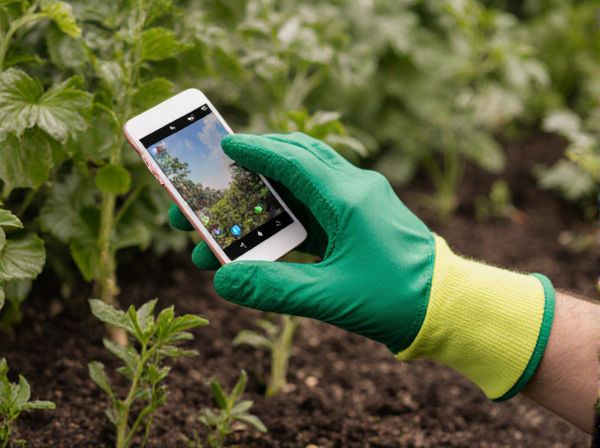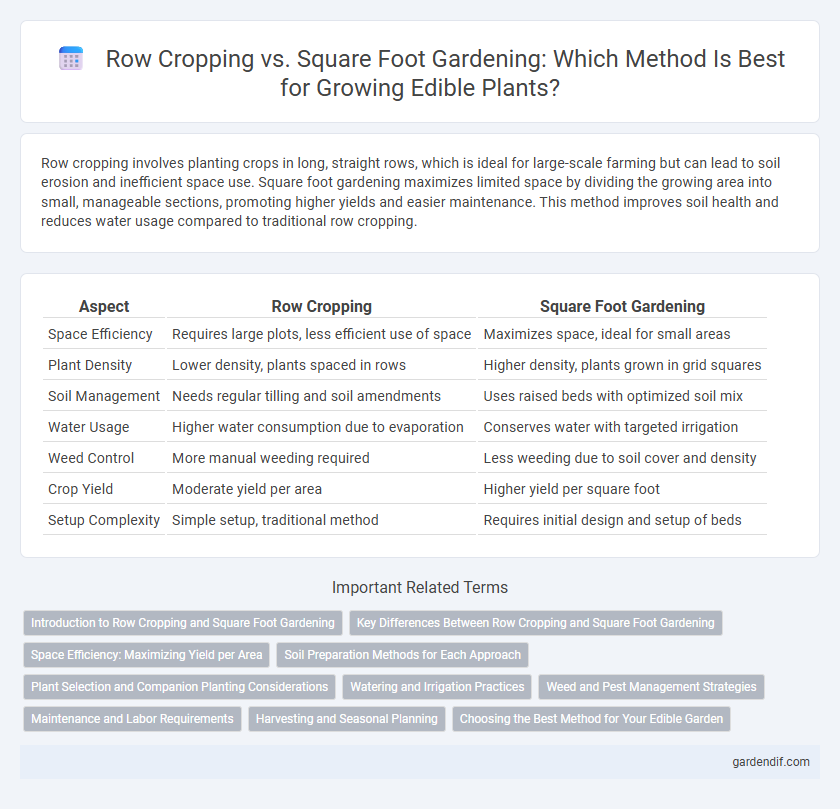
Row cropping vs Square foot gardening Illustration
Row cropping involves planting crops in long, straight rows, which is ideal for large-scale farming but can lead to soil erosion and inefficient space use. Square foot gardening maximizes limited space by dividing the growing area into small, manageable sections, promoting higher yields and easier maintenance. This method improves soil health and reduces water usage compared to traditional row cropping.
Table of Comparison
| Aspect | Row Cropping | Square Foot Gardening |
|---|---|---|
| Space Efficiency | Requires large plots, less efficient use of space | Maximizes space, ideal for small areas |
| Plant Density | Lower density, plants spaced in rows | Higher density, plants grown in grid squares |
| Soil Management | Needs regular tilling and soil amendments | Uses raised beds with optimized soil mix |
| Water Usage | Higher water consumption due to evaporation | Conserves water with targeted irrigation |
| Weed Control | More manual weeding required | Less weeding due to soil cover and density |
| Crop Yield | Moderate yield per area | Higher yield per square foot |
| Setup Complexity | Simple setup, traditional method | Requires initial design and setup of beds |
Introduction to Row Cropping and Square Foot Gardening
Row cropping involves planting crops in long, continuous rows that maximize space for mechanized farming and large-scale production, commonly used for staple crops like corn and soybeans. Square foot gardening divides growing areas into small, manageable sections typically measuring one square foot, optimizing space for intensive planting and easier maintenance, ideal for urban or small-scale gardeners. Both methods offer distinct advantages in terms of space utilization, crop yield, and labor efficiency depending on the gardener's scale and goals.
Key Differences Between Row Cropping and Square Foot Gardening
Row cropping involves planting in long, straight rows with wider spacing, optimizing space for large-scale agriculture and mechanized equipment use. Square foot gardening divides the growing area into small, manageable square sections, maximizing yield in limited spaces and reducing weed growth through dense planting. Key differences include resource efficiency, scale adaptability, and labor intensity, with square foot gardening being ideal for urban or small gardens and row cropping suited for expansive farmland.
Space Efficiency: Maximizing Yield per Area
Row cropping typically requires more space between rows for machinery access, which can reduce overall planting density, while square foot gardening maximizes space by subdividing beds into one-foot sections, allowing intense cultivation within a compact area. Square foot gardening increases yield per square foot by promoting closely spaced planting, minimizing wasted space, and enabling easier management of diverse crops in small urban or backyard gardens. This method outperforms traditional row cropping in space efficiency, making it ideal for gardeners seeking high productivity in limited areas.
Soil Preparation Methods for Each Approach
Row cropping involves deep tilling and large-scale soil amendments to create uniform, loose soil beds that support high-yield crop rows, while Square Foot Gardening utilizes raised beds filled with a custom soil mix composed of equal parts compost, peat moss, and vermiculite for optimal moisture retention and aeration. The intense soil preparation in row cropping often requires heavy machinery and significant labor to manage soil structure and fertility across expansive fields. Conversely, Square Foot Gardening's method promotes efficient nutrient cycling and reduces soil compaction through hand-mixing and precise, small-scale soil management.
Plant Selection and Companion Planting Considerations
Row cropping allows for large-scale planting of monoculture crops like corn and soybeans, which can limit companion planting options due to space and nutrient competition. Square foot gardening optimizes plant selection by encouraging diverse, high-yield crops such as herbs, leafy greens, and root vegetables in close proximity, enhancing companion planting benefits like pest control and nutrient sharing. Companion planting in square foot gardens improves soil health and maximizes limited space, making it ideal for gardeners focusing on plant diversity and sustainability.
Watering and Irrigation Practices
Row cropping requires extensive watering systems such as drip or furrow irrigation to cover large areas efficiently, often consuming more water due to evaporation and runoff. Square foot gardening optimizes water use through densely planted beds and soaker hoses that deliver moisture directly to roots, minimizing waste. Efficient water management in square foot gardening supports healthier plants with less frequent irrigation compared to traditional row cropping.
Weed and Pest Management Strategies
Row cropping often requires extensive herbicide applications and mechanical cultivation to manage weeds, increasing soil disturbance and pest exposure. Square foot gardening employs dense planting and raised beds to naturally suppress weeds and reduce pest habitats, relying on organic mulches and companion planting for integrated pest management. This approach minimizes chemical inputs and promotes healthier, more resilient plant growth in small-scale edible gardens.
Maintenance and Labor Requirements
Row cropping demands extensive labor for soil preparation, planting, weeding, and irrigation across large areas, often requiring mechanized tools or multiple workers. Square foot gardening significantly reduces maintenance by utilizing compact, intensive beds with pre-planned spacing, minimizing weed growth and watering needs. This method promotes efficient labor allocation, making it ideal for gardeners seeking manageable upkeep and higher productivity per square foot.
Harvesting and Seasonal Planning
Row cropping allows for large-scale harvesting with machinery, enabling efficient collection of staple crops over extended seasons. Square foot gardening optimizes space for diverse crops, facilitating staggered planting and frequent, manageable harvests ideal for small spaces or urban settings. Seasonal planning in row cropping aims at maximizing yield cycles, while square foot gardening emphasizes continuous harvest and crop rotation within limited plots.
Choosing the Best Method for Your Edible Garden
Row cropping maximizes space for larger-scale edible gardens by allowing easier access for planting, maintenance, and harvesting of crops like tomatoes, beans, and corn. Square foot gardening optimizes yield in small spaces through dense planting in confined areas, ideal for urban gardeners cultivating herbs, leafy greens, and root vegetables. Selecting the best method depends on available space, crop variety, and maintenance preferences to ensure efficient growth and maximum edible production.
Row cropping vs Square foot gardening Infographic

 gardendif.com
gardendif.com